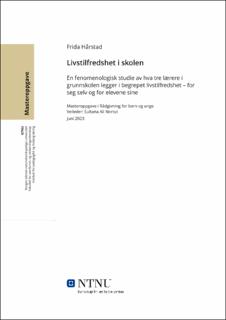| dc.contributor.advisor | Norozi, Sultana Ali | |
| dc.contributor.author | Hårstad, Frida | |
| dc.date.accessioned | 2023-09-29T17:20:39Z | |
| dc.date.available | 2023-09-29T17:20:39Z | |
| dc.date.issued | 2023 | |
| dc.identifier | no.ntnu:inspera:145430779:25680202 | |
| dc.identifier.uri | https://hdl.handle.net/11250/3093183 | |
| dc.description.abstract | Målet med denne studien er å undersøke hva livstilfredshet er for den enkelte lærer, hvordan dette synet utfolder seg i livene deres, samt implementeres i deres hverdag som lærere i klasserommet. Videre undersøker studien hva livstilfredshet er for elevene, men også hvordan lærerens livstilfredshet står i sammenheng med elevenes livstilfredshet.
Livstilfredshet forstås som en tenkningsbasert vurdering av hvordan en har det med livet. Dette med sitt utspring i det flerdimensjonale og internasjonale begrepet well-being. Ulike teorier peker i retning av at livstilfredshet er en form for hedonistisk well-being. Disse teoriene tar utgangspunkt i at følelser utgjør et informasjonssystem, der kroppslige reaksjoner fortolkes av psyken som følelser av behag eller ubehag. I denne oppgaven vektlegges de hedonistiske teoriene, med vekt på den emosjonelle dimensjonen av begrepet livstilfredshet.
Frem til nå har man tatt utgangspunkt i at målet om livsmestring er hensiktsmessig og helsefremmende for den enkelte elev. For mange har begrepet livsmestring kommet med en bismak, der ordet mestring har fått en stor plass i det arbeidet som nå praktiseres i den norske skolen. Gjennom denne studien presenteres leseren for refleksjoner som setter søkelyset på hvordan vi har det med livet, heller enn hvordan vi mestrer det.
Dette er en studie bestående av fire hovedområder for funn og diskusjon; 1. Lærerens forståelse av begrepet livstilfredshet, 2. Faktorer som påvirker livstilfredsheten, 3. Sammenhengen mellom lærerens livstilfredshet og elevenes livstilfredshet og 4. Forskjellen mellom livstilfredshet og livsmestring. Ved hjelp av en forskningsforankring bestående av teori, offentlige dokumenter og tidligere forskning, drøftes informantenes perspektiver i forhold til de nevnte hovedområdene. Metoden som brukes for å undersøke fenomenet livstilfredshet er kvalitativ metode, med semistrukturert intervju som datainnsamlingsmetode.
Funnene i studien indikerer at det er en lite utforsket, men spennende sammenheng mellom lærerens livstilfredshet og elevenes livstilfredshet. Tilfredshet som utgangspunkt synes å være det beste utgangspunktet for å inngå i gode relasjoner med andre, oppleve mestring i eget liv, samt bidra til deltakelse og involvering på samfunnsnivå. | |
| dc.description.abstract | The aim of this study is to examine what life satisfaction means for individual teachers, how it unfolds in their lives, and how it is implemented in their everyday life as teachers in the classroom. Additionally, the study explores what life satisfaction means for students and how the teacher's life satisfaction is connected to the students' life satisfaction.
Life satisfaction is understood as a cognitive evaluation of one's overall life experience. This understanding stems from the multidimensional and international concept of well-being. Various theories suggest that life satisfaction is a form of hedonistic well-being. These theories assume that emotions constitute an information system, where bodily reactions are interpreted by the mind as feelings of pleasure or discomfort. This study emphasizes the hedonistic theories, focusing on the emotional dimension of life satisfaction.
Until now, the assumption has been that the goal of mastering life skills is appropriate and promotes health for individual students. However, for many, the concept of mastering life skills has had a negative connotation, with the word "mastering" taking up a significant space in the current practices of the Norwegian education system. This study presents reflections that shift the focus to how we experience life, rather than how we master it.
This study consists of four main areas of findings and discussion: 1. The teacher's understanding of the concept of life satisfaction, 2. Factors influencing life satisfaction, 3. The connection between the teacher's life satisfaction and the students' life satisfaction, and 4. The difference between life satisfaction and mastering life skills. Drawing on theory, public documents, and previous research, the perspectives of the informants are discussed in relation to these main areas. The research method used to investigate the phenomenon of life satisfaction is qualitative, employing semi-structured interviews as the data collection method.
The findings of the study indicate that there is a relatively unexplored but intriguing connection between the teacher's life satisfaction and the students' life satisfaction. Starting with satisfaction appears to be the best foundation for establishing good relationships with others, mastering life skills, and contributing to participation and involvement at a societal level. | |
| dc.language | nob | |
| dc.publisher | NTNU | |
| dc.title | Livstilfredshet i skolen | |
| dc.type | Master thesis | |
